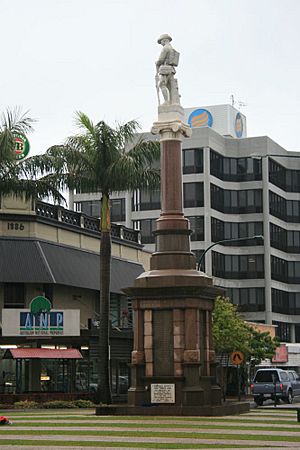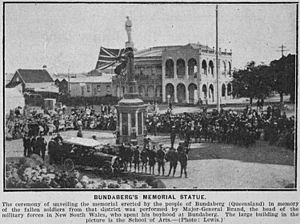Bundaberg War Memorial facts for kids
Quick facts for kids Bundaberg War Memorial |
|
|---|---|

Bundaberg War Memorial, 2009
|
|
| Location | Bourbong Street, Bundaberg Central, Bundaberg, Bundaberg Region, Queensland, Australia |
| Design period | 1919–1930s (interwar period) |
| Built | 1920–1921 |
| Architect | Frederic Herbert Faircloth |
| Architectural style(s) | Classicism |
| Official name: Bundaberg War Memorial | |
| Type | state heritage (built) |
| Designated | 21 October 1992 |
| Reference no. | 600364 |
| Significant period | 1921- (social) 1921(fabric,historical) |
| Significant components | memorial – soldier statue |
| Builders | Anselm & Odling (Sydney) |
| Lua error in Module:Location_map at line 420: attempt to index field 'wikibase' (a nil value). | |
The Bundaberg War Memorial is a special monument in Bundaberg, Queensland, Australia. It is located on Bourbong Street in Bundaberg Central. This important memorial was designed by an architect named Frederic Herbert Faircloth. It was built between 1920 and 1921 by a company called Anselm & Odling from Sydney. The memorial is listed on the Queensland Heritage Register because of its historical importance. It was added to the register on 21 October 1992.
Contents
History of the Bundaberg War Memorial
The Bundaberg War Memorial was first shown to the public on 31 July 1921. However, it was not fully finished then. The soldier statue, which was made in Italy, had not yet arrived. The complete memorial was officially unveiled on 30 July 1921 by Major-General Charles Brand.
The memorial was designed by F. H. Faircloth, a local architect from Bundaberg. The building work was done by Anselm and Odling, who were masonry contractors from Sydney. This monument is made from granite, trachyte, and marble. It honors one local man who served in the Second Boer War. It also remembers 227 local men who served in the First World War.
Why War Memorials Are Important
Before the First World War, Australia did not have many public monuments. The memorials built after this war became our first national monuments. They showed the huge impact the war had on a young country. Australia lost 60,000 people from a population of about 4 million. This meant one out of every five Australians who served in the war died. No other war has affected the nation so much.
Even before the war ended, people started building memorials. These monuments were a way to show national sadness. For those who built them, they were like sacred grave sites. They were substitute graves for Australians whose bodies were buried in battlefields overseas. The word "cenotaph," often used for war memorials, means "empty tomb."
Australian war memorials are special because they don't just remember the dead. Australians were proud that their first big national army was made up entirely of volunteers. These men were worthy of honor, whether they died or not. Many memorials honor everyone from a town who served, not just those who died. This shows how involved communities were in the war.
The "Digger" Statue
In Queensland, the "digger" statue was a very popular choice for war memorials. A "digger" is a term for an Australian soldier. These statues represented the Anzac spirit. They showed qualities like loyalty, courage, youth, and strength. The digger statue was especially common in Queensland. This might be because other states had groups of architects and artists who guided memorial designs. These experts often did not highly regard the digger statue.
Most digger statues were made by local stone-working companies. However, some were made by artists or brought in from other countries. The Bundaberg digger statue was imported from Italy. It is made of Italian marble.
The Bundaberg War Memorial cost £1,650 to build. This made it the third most expensive memorial in Queensland at the time. It is a major regional memorial. It is also one of the two most complete digger memorials still in their original locations. The other one is in Aramac.
The Architect and Builders
The architect, F. H. Faircloth, was born in Maryborough around 1870. He learned his skills from another architect in Bundaberg. He then started his own business in 1893. Faircloth was known for rebuilding much of the Childers town center after a big fire in 1902. He also designed many important buildings in Bundaberg.
Anselm and Odling were the masons who built the memorial. They were a large company with offices in Australia, London, and Italy. Their international connections allowed them to bring Italian marble digger statues into Australia. They supplied many building materials and often worked on memorials.
What the Memorial Looks Like
The First World War Memorial stands at the main intersection of Bundaberg. It is on a traffic island with strips of grass and concrete. The memorial's height fits well with the nearby Post Office tower.
The memorial is very tall, standing about 38 feet (11.6 meters) high. It has a large base called a pedestal. On top of the pedestal is a tall, round structure called a column. A digger statue stands on top of the column.
The Pedestal
The monument rests on a large pedestal made of trachyte and granite. The pedestal has a central square pillar. There are also square pillars at each corner. The central pillar sits on a simple base. It has sections of stone with bands. The middle part of each side has the names of soldiers carved and gilded (covered in gold). These include one local soldier from the Boer War and 277 from the First World War. Plates honoring those who served in later wars have also been added to the pedestal.
The corner pillars have their own bases. They have small decorative tops called cornices. Above these are rough stone blocks. From these blocks, red granite pillars rise up. The entire pedestal is topped with a large decorative band called a frieze and another cornice.
The Column and Statue
Above the cornice, there is an eight-sided base made of trachyte. This base has two steps. On top of this is a round step. This forms the base for a red granite column. The column has a marble top, known as an Ionic capital, which is a classic Greek style.
The marble digger statue stands on top of the column. It is life-sized. The soldier in the statue has his head bowed. His hands rest on a rifle, which is held upside down. He also carries a backpack. His right leg is slightly bent, making him look relaxed.
Why the Memorial is Heritage-Listed
The Bundaberg War Memorial was added to the Queensland Heritage Register on 21 October 1992. This means it is a very important historical site. Here's why:
- It shows how Queensland's history has changed. War memorials show a common part of Queensland's history. They represent a time when people felt very proud of Australia, especially during and after the First World War. These monuments are a unique record of that time. They also show what people liked in terms of art and design between the wars.
- It is a rare and special part of Queensland's culture. This memorial is a major regional monument. It is uncommon because it is still in its original and complete location. It also records local people who fought in both the South African Boer War and the First World War.
- It shows the main features of this type of monument. The memorial was built in 1921. It clearly shows what a monument built to remember a big historical event should look like. It uses the right materials and design. As a digger statue, it is a great example of the most popular type of memorial in Queensland.
- It is beautiful and well-designed. This statue has special details, like the backpack. It also uses unusual materials. It is important for its beauty because of its excellent craftsmanship, materials, and design. It stands out as a major landmark in the street.
- It is very important to the community. The memorial has a strong connection with the Bundaberg community. It shows how much a major historical event affected them. It also has a special link to the Bundaberg architect, F. H. Faircloth.



